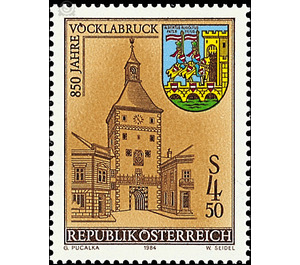850 years - Austria / II. Republic of Austria 1984 - 4.50 Shilling
Theme: Architecture
| Country | Austria / II. Republic of Austria |
| Issue Date | 1984 |
| Face Value | 4.50 |
| Color | multi-colored brown |
| Printing Type | combination printing |
| Stamp Type | Commemorative |
| Item Type | Stamp |
| Chronological Issue Number | 1120 |
| Chronological Chapter | OOS-OE2 |
| SID | 270290 |
| In 73 Wishlists | |
The district town of Vöcklabruck celebrated its 850th "Name Day" in 1984, because in a document from the year 1134, which refers to the donation of a bridge over the Vöckla, the name "pons Veckelahe" appears for the first time. 1143 built Pilgrim of Wenge next to this bridge a church in honor of St. Aegidius and a hospital for pilgrims and the poor, which was the third oldest in German-speaking countries besides Friesach (Carinthia) and Erfurt (Thuringia). In the course of time a settlement named "Villa Veclabrucce" developed next to the bridge, this district of Vöcklabruck still bears the name of the translation of the Latin word "villa", namely "Dörfl". The city was already in Roman times an important road junction on the national road Lorch-Wels-Salzburg. In the middle of the 13th century, the settlement was raised to the market. In a document from the year 1353 the place was first called "city". The city's great patron, Emperor Maximilian I, had the two city towers decorated with magnificent coat of arms frescoes around 1500, which were rediscovered and restored in 1957-59. Thus Vöcklabruck possesses the only towers still preserved in Austria with coat of arms frescoes. The brand motif shows the "lower city tower" and the coat of arms.


